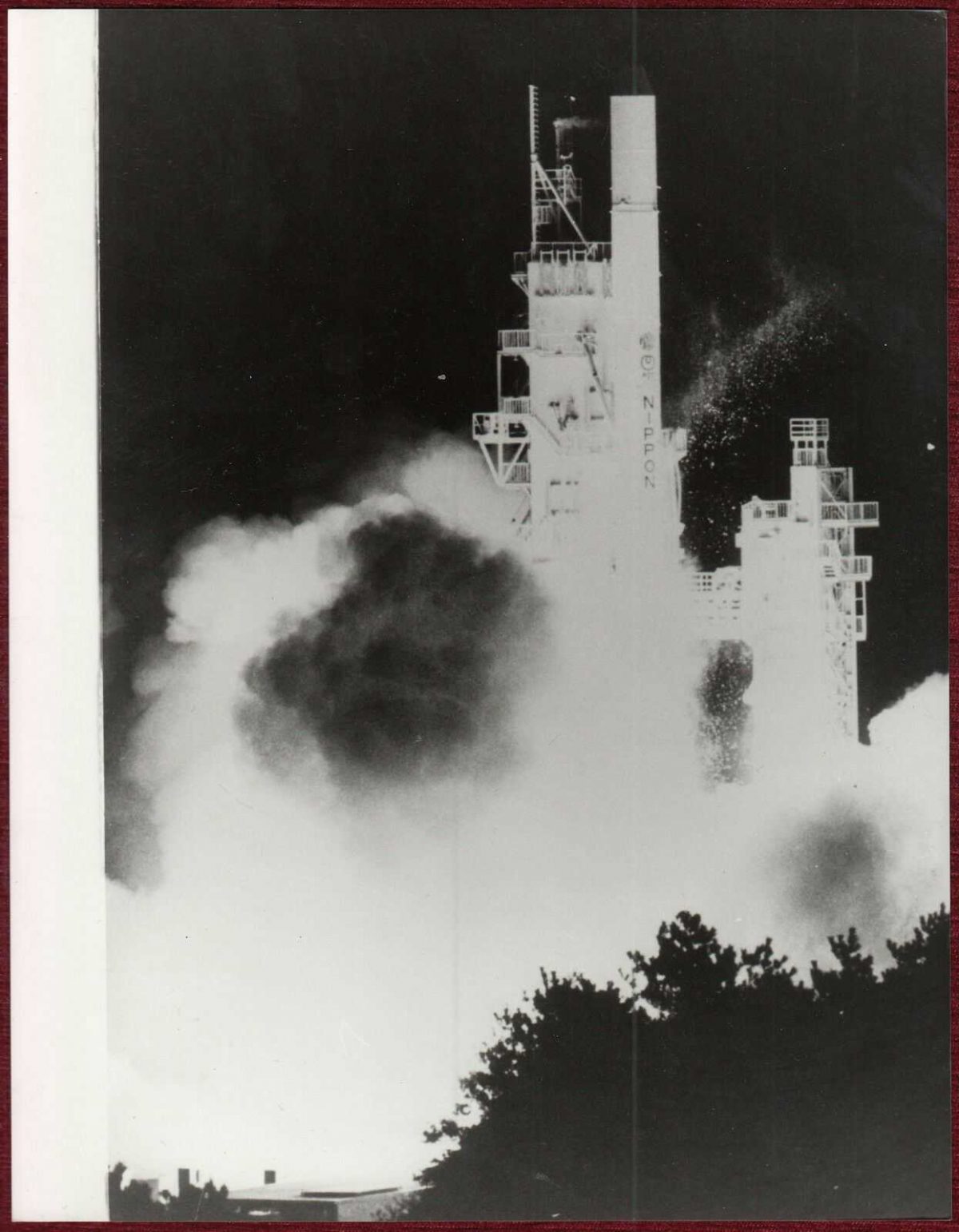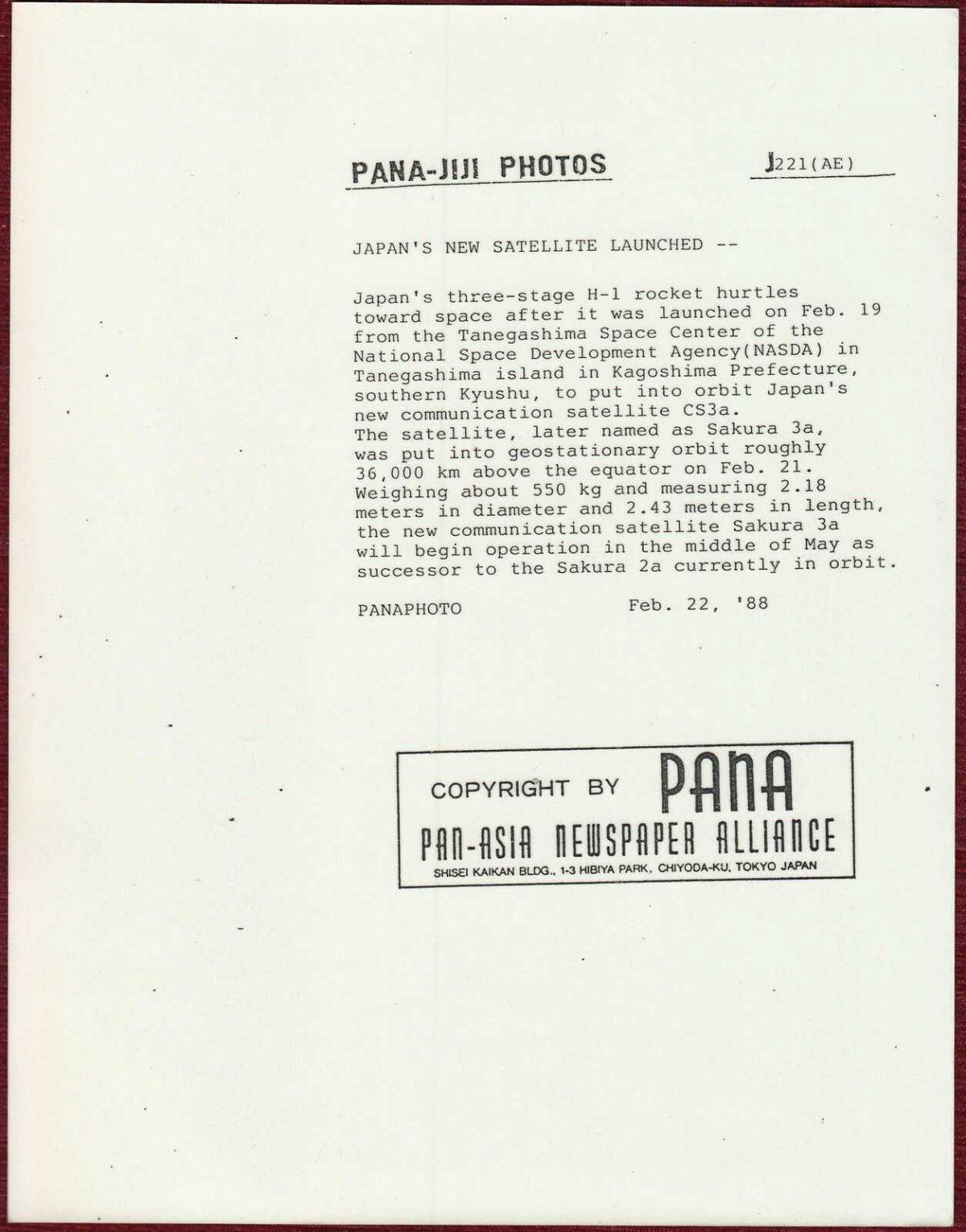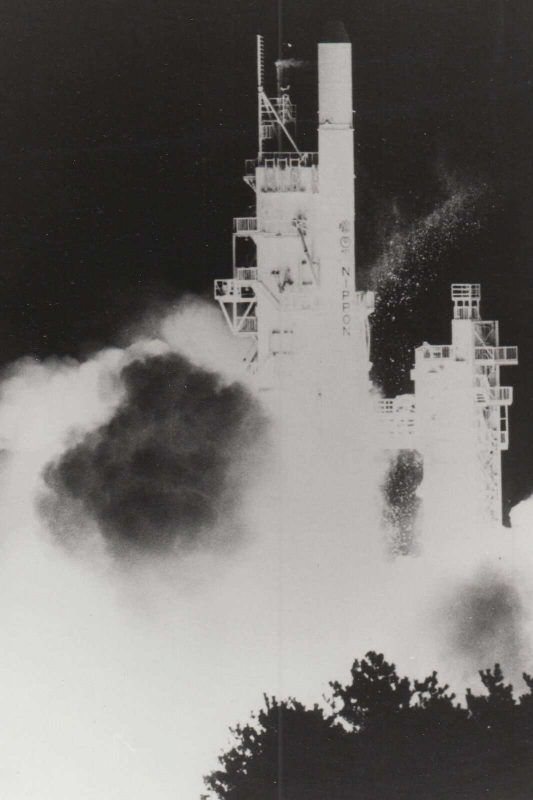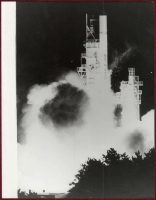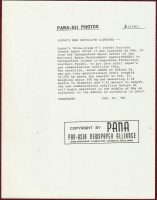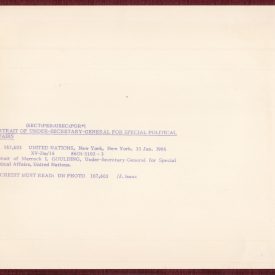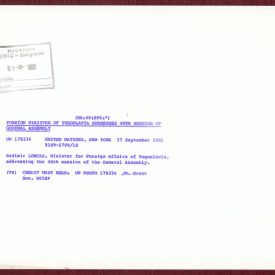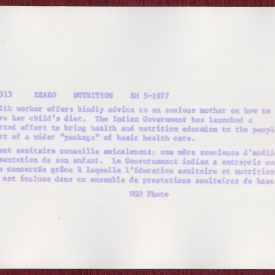1988 ORIGINAL PAN-ASIA NEWSPAPER ALLIANCE AGENCY PHOTO
JAPAN’S NEW SATELLITE LAUNCHED.
The launching of Japan’s H-1 rocket WITH CS3A SATELLITE.
Japan, February 22nd, 1988.
PAN-ASIA NEWSPAPER ALLIANCE (PANA)
PANAPHOTO
***
Size: 17, 7 x 22, 7 cm.
***
Slightly curved.
For the condition and details see the scan.
***
From Wikipedia, the free encyclopedia:
The National Space Development Agency (??????? Uchu Kaihatsu Jigyodan?) of Japan, or NASDA, was a Japanese national space agency established on October 1, 1969 under the National Space Development Agency Law only for peaceful purposes. Based on the Space Development Program enacted by the Minister of Education, Culture, Sports, Science and Technology (MEXT), NASDA was responsible for developing satellites and launch vehicles as well as launching and tracking them.
Hideo Shima, chief engineer of the original Shinkansen “bullet train” project, served as Chief of NASDA from 1969 to 1977.[1]
On October 1, 2003, NASDA merged with the Institute of Space and Astronautical Science (ISAS) and the National Aerospace Laboratory of Japan (NAL) into one Independent Administrative Institution: the Japan Aerospace Exploration Agency (JAXA).
SL-J was partially funded by Japan through NASDA; this cooperative Japanese-American mission launched a NASDA astronaut into Earth orbit using the Space Shuttle in 1992.[2]
Work on the Japanese Experiment Module at ISS, and also HOPE-X, was started under NASDA and inherited by JAXA.
***
The Japan Aerospace Exploration Agency (???????????????? Dokuritsu-gyosei-hojin Uchu Koku Kenkyu Kaihatsu Kiko?, literally “Independent Administrative Institution on Aerospace Research and Development “), or JAXA, is Japan’s national aerospace agency. Through the merger of three previously independent organizations, JAXA was formed on October 1, 2003, as an Independent Administrative Institution administered by the Ministry of Education, Culture, Sports, Science and Technology (MEXT) and the Ministry of Internal Affairs and Communications (MIC).[2] JAXA is responsible for research, technology development and the launch of satellites into orbit, and is involved in many more advanced missions, such as asteroid exploration and possible manned exploration of the Moon.[3] Its motto is One JAXA[4] and its corporate slogan is Reaching for the skies, exploring space.[5]
History
JAXA Kibo, the largest module of the ISS.
On October 1, 2003, three organizations were merged to form the new JAXA: Japan’s Institute of Space and Astronautical Science (or ISAS), the National Aerospace Laboratory of Japan (NAL), and National Space Development Agency of Japan (NASDA).
Before the merger, ISAS was responsible for space and planetary research, while NAL was focused on aviation research. NASDA, which was founded on October 1, 1969, had developed rockets, satellites, and also built the Japanese Experiment Module. The old NASDA headquarters were located at the current site of the Tanegashima Space Center, on Tanegashima Island, 115 kilometers south of Kyushu. NASDA also trained Japanese astronauts, who flew with the US Space Shuttles.[6]
Rockets
JAXA uses the H-IIA (H “two” A) rocket from the former NASDA body to launch engineering test satellites, weather satellites, etc. For science missions like X-ray astronomy, JAXA has been using the M-V (“Mu-five”) solid-fueled rocket from the former ISAS. For experiments in the upper atmosphere JAXA uses the SS-520, S-520, and S-310 sounding rockets.
Successes
Prior to the establishment of JAXA, ISAS had been most successful in its space program in the field of X-ray astronomy during the 1980s and 1990s. Another successful area for Japan has been Very Long Baseline Interferometry (VLBI) with the HALCA mission. Additional success was achieved with solar observation and research of the magnetosphere, among other areas.
NASDA was mostly active in the field of communication satellite technology. However, since the satellite market of Japan is completely open, the first time a Japanese company won a contract for a civilian communication satellite was in 2005. Another prime focus of the NASDA body is Earth climate observation.
JAXA was awarded the Space Foundation’s John L. “Jack” Swigert, Jr., Award for Space Exploration in 2008.[7]
Launch development and missions
H-IIA & H-IIB
Rocket history
Japan launched its first satellite, Osumi, in 1970, using ISAS’ L-4S rocket. Rather than using solid-fuelled rockets, Japan chose a much slower path, with liquid-fuelled rocket technology. In the beginning, NASDA used licensed American models. The first model of rocket developed in Japan was the H-II, introduced in 1994. However, at the end of the 1990s, with two H-II launch failures, Japanese rocket technology began to face criticism.
Early H-IIA missions
Japan’s first space mission under JAXA, an H-IIA rocket launch on November 29, 2003, ended in failure due to stress problems. After a 15 month hiatus, JAXA performed a successful launch of an H-IIA rocket from Tanegashima Space Center, placing a satellite into orbit on February 26, 2005.
Lunar and interplanetary missions
Japan’s first missions beyond Earth orbit were the 1985 Halley comet observation satellites Suisei and Sakigake. To prepare for future missions, ISAS tested Earth swing by orbits with the Hiten mission in 1990. The first Japanese interplanetary mission was the Mars Orbiter Nozomi (Planet-B), which was launched in 1998. It reached its target in 2003, but orbit injection had to be given up. Currently interplanetary missions remain at the ISAS group under the JAXA umbrella. However for FY 2008 JAXA is planning to set up an independent working group within the organization. New head for this group will be Hayabusa project manager Kawaguchi. [1] Active Mission: Hayabusa, SELENE, Under Development: Planet-C, BepiColombo, Hayabusa 2?
Small body exploration: Hayabusa mission
Hayabusa
On May 9, 2003, Hayabusa (meaning, Peregrine falcon), was launched from an M-V rocket. The goal of this mission is to collect samples from a small near-Earth asteroid named 25143 Itokawa. The craft was scheduled to rendezvous in November 2005, and return to Earth with samples from the asteroid by July 2007. It was confirmed that the spacecraft successfully landed on the asteroid on November 20, 2005, after some initial confusion regarding the incoming data. On November 26, 2005, Hayabusa succeeded in making a soft contact, but whether it gathered the samples or not is unknown. Hayabusa returned to Earth on June 13, 2010.
See also: Hayabusa 2
Solar sail research
Main article: solar sail
On August 9, 2004, ISAS successfully deployed two prototype solar sails from a sounding rocket. A clover type sail was deployed at 122 km altitude and a fan type sail was deployed at 169 km altitude. Both sails used 7.5 micrometer thick film.
ISAS tested a solar sail again as a sub payload to the Astro-F (Akari) mission on February 22, 2006. However the solar sail did not deploy fully. ISAS tested a solar sail again as a sub payload of the Solar-B launch at September 23, 2006, but contact with the probe was lost. The IKAROS solar sail was launched on May 21, 2010. The solar sail deployed successfully. The goal is to have a solar sail mission to Jupiter after 2010.
Lunar explorations
After Hiten in 1990, ISAS planned a lunar exploration mission LUNAR-A but after delays due to technical problems, the project was terminated in January 2007. The seismometer penetrator design for Lunar-A may be reused in future mission.
On September 14, 2007, JAXA succeeded in launching lunar orbit explorer Kaguya, also known as SELENE (costing 55 billion yen including launch vehicle), the largest such mission since the Apollo program, on an H-2A rocket. Its mission is to gather data on the moon’s origin and evolution. It entered into a lunar orbit on October 4, 2007.[8][9]
Astronomy program
See also: Scientific research on the ISS
The first Japanese astronomy mission was x-ray satellite Hakucho (Corsa-B), which was launched in 1979. Later ISAS moved into solar observation, radio astronomy through Space VLBI and infrared astronomy. Active Mission: Suzaku, Akari, Hinode Under Development: ASTRO-G, ASTRO-H
Infrared astronomy
AKARI (Astro-F)
ASTRO-E
Japan’s first infrared astronomy mission was the 15 cm IRTS telescope which was part of the SFU multipurpose satellite in 1995. IRTS scanned during its one month lifetime around 7% of the sky before SFU got brought back to Earth by the Space Shuttle. During the 1990s JAXA also gave ground support for the ESA Infrared Space Observatory (ISO) infrared mission.
The next step for JAXA was the AKARI spacecraft, with the pre-launch designation ASTRO-F. This satellite was launched on 21 February 2006. Its mission is infrared astronomy with a 68 cm telescope. This is the first all sky survey since the first infrared mission IRAS in 1983. (A 3.6 kg nanosatellite named CUTE-1.7 was also released from the same launch vehicle.) [2]
JAXA is also doing further R&D for increasing the performance of its mechanical coolers for its future infrared mission SPICA. This would enable a warm launch without liquid helium. SPICA has the same size as the ESA Herschel Space Observatory mission, but is planned with a temperature of just 4.5 K to be much colder. The launch is planned for the year 2015, however the mission is not yet fully funded. Also ESA and NASA might contribute an instrument each. [3]
X-ray astronomy
Starting from 1979 with Hakucho (CORSA-B), Japan achieved for nearly 20 years continuous observation with its Hinotori, Tenma, Ginga and Asuka (ASTRO-A to D) x-ray observation satellites. However in the year 2000 the launch of Japan’s fifth x-ray observation satellite ASTRO-E failed (as it failed at launch it never received a proper name).
Then on July 10, 2005, JAXA was finally able to launch a new X-ray astronomy mission named Suzaku (ASTRO-E II). This launch was important for JAXA, because in the five years since the launch failure of the original ASTRO-E satellite, Japan was without an x-ray telescope. Three instruments were included in this satellite: an X-ray spectrometer (XRS), an X-ray imaging spectrometer (XIS), and a hard X-ray detector (HXD). However, the XRS was rendered inoperable due to a malfunction which caused the satellite to lose its supply of liquid helium.
The next planned x-ray mission is the Monitor of All-sky X-ray Image (MAXI). It will continuously monitors astronomical X-ray objects over a broad energy band (0.5 to 30 keV). MAXI will be installed on the Japanese external module of the ISS. [10] After this mission JAXA plans to launch ASTRO-H, also known under the name NeXT, in the summer of 2013.
See also: ASTRO-H
Solar astronomy
Japan’s solar astronomy started in the early 80s with the launch of the Hinotori (ASTRO-A) x-ray mission. The Hinode (SOLAR-B) spacecraft, the follow-on to the Japan/US/UK Yohkoh (SOLAR-A) spacecraft, was launched on 23 September 2006. [4] [5] A SOLAR-C can be expected sometime after 2010. However no details are worked out yet other than it will not be launched with the former ISASs Mu rockets. Instead H-2A from Tanegashima could launch it. As H-2A is more powerful SOLAR-C could either be heavier or be stationed at L1 (Lagrange point 1).
Radio astronomy
In 1998 Japan launched the HALCA (Muses-B) Mission, the world first spacecraft dedicated to create SPACE VLBI observations of Pulsars among others. To do so, ISAS set up a ground network around the world through international cooperation. The observation part of the mission lasted until 2003 and the satellite was retired at the end of 2005. In FY 2006 Japan funded the ASTRO-G as the succeeding mission. Launch is planned for FY 2012.
For details see:
ASTRO-G HALCA
Technology tests
One of the primary duties of the former NASDA body was the testing of new space technologies, mostly in the field of communication. The first test satellite was ETS-I,launched in 1975. However during the 1990s NASDA was hit by bad luck with the problems surrounding the ETS-VI and COMETS missions.
Testing of communication technologies remains as one of the Jaxas key duties in cooperation with NICT. Active Mission: ETS-VIII, WINDS, Index Under Development: QZSS-1 Retired: OICETS
ETS-VIII and WINDS
To upgrade Japan’s communication technology the Japanese state launched the i-Space initiative with the ETS-VIII and WINDS missions.[6]
ETS-VIII was launched on December 18, 2006. The purpose of ETS-VIII is to test communication equipment with two very large antennas and an atomic clock test. On December 26 both antennas were successfully deployed. This didn’t come unexpected, since JAXA tested the deployment mechanism before with the LDREX-2 Mission, which was launched on October 14 with the European Ariane 5. The test was successful. The mission of WINDS is to create the worlds fastest satellite internet connection. WINDS was launched in February 2008.
OICETS and INDEX
On August 24, 2005, JAXA launched the experimental satellites OICETS and INDEX with the Dnepr rocket. OICETS mission is to test optical links with the European Space Agency (ESA) satellite ARTEMIS, which is around 40,000 km away from OICETS. The experiment was successful on December 9, when the link could be established. In March 2006 Jaxa could establish with OICETS the worldwide first optical links between a LEO satellite and a ground station first in Japan and in June 2006 with a mobile station in Germany.
INDEX is a small 70 kg satellite for testing various equipment and for a small aurora observation mission. The satellite is currently in the extended mission phase.
Earth observation programme
Japan’s first Earth observation satellites were MOS-1a and MOS-1b launched in 1987 and 1990. During the 1990s and the new millennium this programme came under heavy fire, because both Adeos (Midori) and Adeos 2 (Midori 2) satellites failed after just 10 months in orbit.
Active Mission: ALOS, GOSAT Under Development: GCOM-W, GCOM-C, ALOS 2 SAR
[edit] ALOS
MTSAT-1
In January 2006, JAXA successfully launched the Advanced Land Observation Satellite (ALOS/Daichi). Communication between ALOS and the ground station in Japan will be done through the Kodama Data Relay Satellite, which was launched during 2002. This project is under intense pressure due to the shorter than expected lifetime of the ADEOS II (Midori) Earth Observation Mission. For the following on mission JAXA plans to split the mission into a radar satellite and an optical satellite. ALOS 2 SAR is currently planned for the winter of FY 2012.
Rainfall observation
Since Japan is an island nation and gets struck by typhoons every year, research about the dynamics of the atmospheric is a very important issue. For this reason Japan launched in 1997 the TRMM mission in cooperation with NASA, to observe the tropical rainfall seasons. JAXA and NASA are planning a successor to the TRMM mission. However because of NASA budget problems the launch date of the GPM project got pushed back to the year 2013. For further research NASDA although launched the ADEOS and ADEOS II missions in 1996 and 2003. However due to various reasons both satellites had a much shorter than expected life term.
Monitoring of carbon dioxide
At the end of the 2008 fiscal year, JAXA launched the satellite GOSAT (Greenhouse Gas Observing SATellite) to help scientists determine and monitor the density distribution of carbon dioxide in the atmosphere. The satellite is being jointly developed by JAXA and Japan’s Ministry of the Environment. JAXA is building the satellite while the Ministry is in charge of the data that will be collected. Since the number of ground-based carbon dioxide observatories cannot monitor enough of the world’s atmosphere and are distributed unevenly throughout the globe, the GOSAT may be able to gather more accurate data and fill in the gaps on the globe where there are no observatories on the ground. Sensors for methane and other greenhouse gasses are also being considered for the satellite, although the plans are not yet finalized. The satellite weighs approximately 1650 kg and is expected to have a life span of 5 years.
GCOM series
Next funded earth observation mission after GOSAT is the GCOM earth observation programme as a successor to ADEOS II (Midori) and the Aqua mission. To reduce the risk and for a longer observation time the mission will be split into smaller satellites. Altogether GCOM will be a series of six satellites. First launch, GCOM-W is scheduled for February 2012 with the H-IIA. Second launch GCOM-C is currently planned for February 2014.
Satellites for other agencies
For weather observation Japan launched on February 2005 the Multi-Functional Transport Satellite 1R (MTSAT-1R). The success of this launch was critical for Japan, since the original MTSAT-1 couldn’t be put into orbit because of a launch failure with the H-2 rocket in 1999. Since then Japan relied for weather forecasting on an old satellite which was already beyond its useful life term and on American systems.
On February 18, 2006, JAXA, as head of the H-IA at this time, successfully launched the MTSAT-2 aboard a H-2A rocket. MTSAT-2 is the backup to the MTSAT-1R. The MTSAT-2 uses the DS-2000 satellite bus developed by Mitsubishi Electric.[11] The DS-2000 is also used for the DRTS Kodama, ETS-VIII and the Superbird 7 communication satellite, making it the first commercial success for Japan.
As a secondary mission both the MTSAT-1R and MTSAT-2 help to direct air traffic.
Other JAXA satellites currently in use
Exos-D (Akebono) Aurora Observation, since 1989.
GEOTAIL magnetosphere observation satellite (since 1992)
DRTS (Kodama) Data Relay Satellite, since 2002. (Projected Life Span is 7 years)
On going joint missions with NASA are the Tropical Rainfall Measuring Mission (TRMM), the Aqua Earth Observation Satellite.
Finished missions
OICETS, Technology Demonstration 2005-2009 (retired)
SELENE, Moon probe 2007-2009 (retired)
Micro Lab Sat 1, Small engineering mission, launch 2002. (retired 27 September 2006)
HALCA, Space VLBI 1997-2005 (retired)
Nozomi, Mars Mission 1998-2003 (failed)
MDS-1, Technology Demonstration 2002-2003 (retired)
ADEOS 2, (Midori 2) Earth Observation 2002-2003 (lost)
Future missions
HTV-1
As JAXA shifted away from international efforts beginning in 2005, plans are developing for independent space missions, such as a proposed manned mission to the moon.
2009 and beyond
Ambox outdated serious.svg
This section may need to be updated. Please update this section to reflect recent events or newly available information, and remove this template when finished. Please see the talk page for more information. (November 2010)
On February 23, 2008 JAXA launched the Wideband InterNetworking engineering test and Demonstration Satellite (WINDS), also called “KIZUNA.” WINDS will facilitate experiments with faster internet connections. The launch, using H-IIA launch vehicle 14, took place from the Tanegashima Space Center.[12]
On September 10, 2009 the first H-IIB rocket was successfully launched, delivering the HTV-1 freighter to resupply the International Space Station.[13]
Another project is the Global Precipitation Measurement/Dual-frequency Precipitation Radar (GPM/DPR) which is a joint development with NASA. This mission is the successor to the highly successful TRMM mission. JAXA will develop the radar and provide the launch vehicle. Other countries/agencies like China, India, ESA etc. will provide the subsatellites. The aim of this mission is to measure global rainfall. However because of NASA budget limitations this project was pushed back to 2010.
In the year 2009 JAXA plans to launch the first satellite of the Quasi Zenith Satellite System (QZSS), a subsystem of the global positioning system (GPS). Two others are expected to follow later. If successful, one satellite will be in a zenith position over Japan full time. The QZSS mission is the last scheduled major independent mission for JAXA, as no major civilian projects were funded after that for now. The only exception is the IGS programme which will be continued beyond 2008. However it seems Japan is pressing forward now with the GCOM earth observation satellites as successors to the ADEOS missions. First launch is planned for 2010. In 2009 Japan also plans to launch a new version of the IGS with an improved resolution of 60 cm.
Launch schedule
First launch of the H-IIB and the HTV is September 1, 2009. After the first flight one HTV launch is planned during each FY until 2015. (If not mentioned otherwise launch vehicle for the following missions
FY 2010
H-II Transfer Vehicle, Unmanned resupply spacecraft, launch: Winter, 2010
Quasi Zenith Satellite System, launch: Aug, 2010
Akatsuki, probe to Venus, launch: May, 2010
IKAROS, Solar-sail Technology Demonstration satellite, launch: May, 2010
FY 2011
GCOM-W, Climate Observation satellite, launch: Feb, 2012
FY 2012
ALOS 2 SAR, Earth Observation satellite, launch: Winter 2012
ASTRO-G (VSOP-2) successor to the Halca mission, launch: Summer 2012
TOPS Telescope Observatory for Planets on Small-satellite launch Feb, 2012 (First launch of the new Advanced Solid Rocket, the successor to the M-V.
FY 2013
GPM, successor to the TRMM joint NASA mission
BepiColombo, joint ESA mission to Mercury, launch: 2013 (LV: Ariane 5)
ASTRO-H x-ray observatory, launch: summer 2013.
GCOM-C, Climate Observation satellite, launch: Feb, 2014
Other missions
For the 2012 ESA EarthCare mission, JAXA will provide the radar system on the satellite. JAXA is also providing the Light Particle Telescope(LPT) for the 2008 Jason 2 satellite by the French CNES. JAXA will provide the Auroral Electron Sensor (AES) for the Taiwanese FORMOSAT-5.[7]
SmartSat-1, small communication test and sun corona observation, Mission status unclear
XEUS joint X-Ray telescope with ESA, launch after 2015.
Sohla-2 Small PETSAT Demonstration Satellite
New orientation of JAXA
Planning interplanetary research missions can take up to seven years, such as the ASTRO-E. Due to the lag time between these interplanetary events and mission planning time, opportunities to gain new knowledge about the cosmos might be lost. To prevent this, JAXA plans on using smaller, faster missions from 2010 onwards. JAXA is also planning to develop a new solid fueled rocket to replace the twelve year old M-V.
Developing projects
IKAROS (Interplanetary Kite-craft Accelerated by Radiation Of the Sun), a small size powered-solar sail experimental spacecraft. Future mission will use solar sail for Jupiter and Trojan asteroids exploration.
Plans
Selene-2, a moon landing mission
Hayabusa 2, for launch in 2014-2015 for target 1999JU3
Hayabusa Mk2/Marco Polo
Human Lunar Systems, conceptual system study on the future human lunar outpost
ALOS 2, earth observation
SPICA, a 3,5 meter infrared telescope to be placed at L2
JASMINE, infrared telescope for measuring the universe
DIOS, small scale x-ray observation
Space Solar Power System (SSPS), space-based solar power prototype launch in 2020, aiming for a full power system in 2030[14]
Human space program
The Spacelab-J shuttle flight, funded by Japan, included several tons of Japanese science research equipment
Japan has ten astronauts but has not yet developed its own manned spacecraft and is not currently developing one officially. Sometime ago[when?] an unmanned mainly and manned prospectively space shuttle-spaceplane HOPE-X project launched by conventional space launcher H-II was developed for several years (including test flights of Hyflex/OREX prototypes) but was postponed. Then the simpler manned capsule Fuji was proposed but not adopted. Projects of single-stage to orbit, reusable launch vehicle horizontal takeoff and landing ASSTS and vertical takeoff and landing Kankoh-maru also exist but have not been adopted.
The first Japanese citizen to fly in space was Toyohiro Akiyama, a journalist sponsored by TBS, who flew on the Soviet Soyuz TM-11 in December 1990. He spent more than seven days in space on the Mir space station, in what the Soviets called their first commercial spaceflight which allowed them to earn $14 million.
Japan participates in US and international manned space programs including flights of Japanese astronauts on a board of US Space Shuttles, Russian Soyuz spacecraft and ISS. Besides this paid for seat flights, one Space Shuttle mission (STS-47, which occurred in September 1992) was partially funded by Japan. On board STS-47 was Japan’s first professional astronaut Mamoru Mohri, as the Payload Specialist for the Spacelab-J, one of the European built Spacelab modules. This mission was also designated Japan.
A view of the completed Kibo module.
Mainly for Japan, another three US Space Shuttles missions (STS-123, STS-124, STS-127) were in 2008-2009 for delivery of parts of Japan built spacelab-module Kibo to ISS.
Under a new plan, Japan and JAXA has set a goal of constructing a manned lunar base. Japanese robots and then astronauts would be sent to the Moon by beyond 2020 which is approximately the same time as Indian Space Research Organisation (ISRO) manned lunar mission beyond 2020, China National Space Administration (CNSA) manned lunar mission near 2030. NASA is currently developing the Multi-Purpose Crew Vehicle (MPCV) which is based on the Orion design for traveling beyond Low Earth Orbit (LEO). The MPCV is capable of translunar trajectory. [15]
Before this Moon goals JAXA intends to develop the manned capsule spacecraft launched by space launcher H-IIB. [8]
Supersonic aircraft development
Besides the H-IIA and M-5 rockets, JAXA is also developing technology for a next-generation supersonic transport that could become the commercial replacement for the Concorde. The design goal of the project (working name NEXST) is to develop a jet that can carry 300 passengers at Mach 2. A subscale model of the jet underwent aerodynamic testing in September and October 2005 in Australia.[16][dead link] The economic success of such a project is still unclear, and as a consequence the project has been met with limited interest from Japanese aerospace companies like Mitsubishi Heavy Industries so far.
Reusable launch vehicles
Until 2003[citation needed] JAXA (ISAS) conducted research on a reusable launch vehicle under the Reusable Vehicle Testing (RVT) project.
Research centers and offices
Head Office
Tanegashima Space Center
JAXA has research centers in many locations in Japan, and some offices overseas. Its headquarters are in Chofu, Tokyo. It also has
Earth Observation Research Center (EORC), Tokyo
Earth Observation Center (EOC) in Hatayama
Noshiro Testing Center (NTC) – Established in 1962. It carries out development and testing of rocket engines.
Sanriku Balloon Center (SBC) – Balloons have been launched from this site since 1971.
Kakuda Space Propulsion Center (KSPC) – Leads the development of rocket engines. Works mainly with development of liquid fuel engines.
Sagamihara Campus (ISAS) – Development of experimental equipment for rockets and satellites. Also administrative buildings.
Tanegashima Space Center
Tsukuba Space Center (TKSC) in Tsukuba. This is the center of Japan’s space network. It is involved in research and development of satellites and rockets, and tracking and controlling of satellites. It develops experimental equipment for the Japanese Experiment Module (“Kibo”). Training of astronauts also takes place here. For International Space Station operations, the Japanese Flight Control Team is located at the Space Station Integration & Promotion Center (SSIPC) in Tsukuba. SSIPC communicates regularly with ISS crewmembers via S-band audio.[17]
Uchinoura Space Center
Other space agencies in Japan
Not included into the JAXA organization is the Institute for unmanned space experiment free flyer (USEF), Japan’s other space agency.


